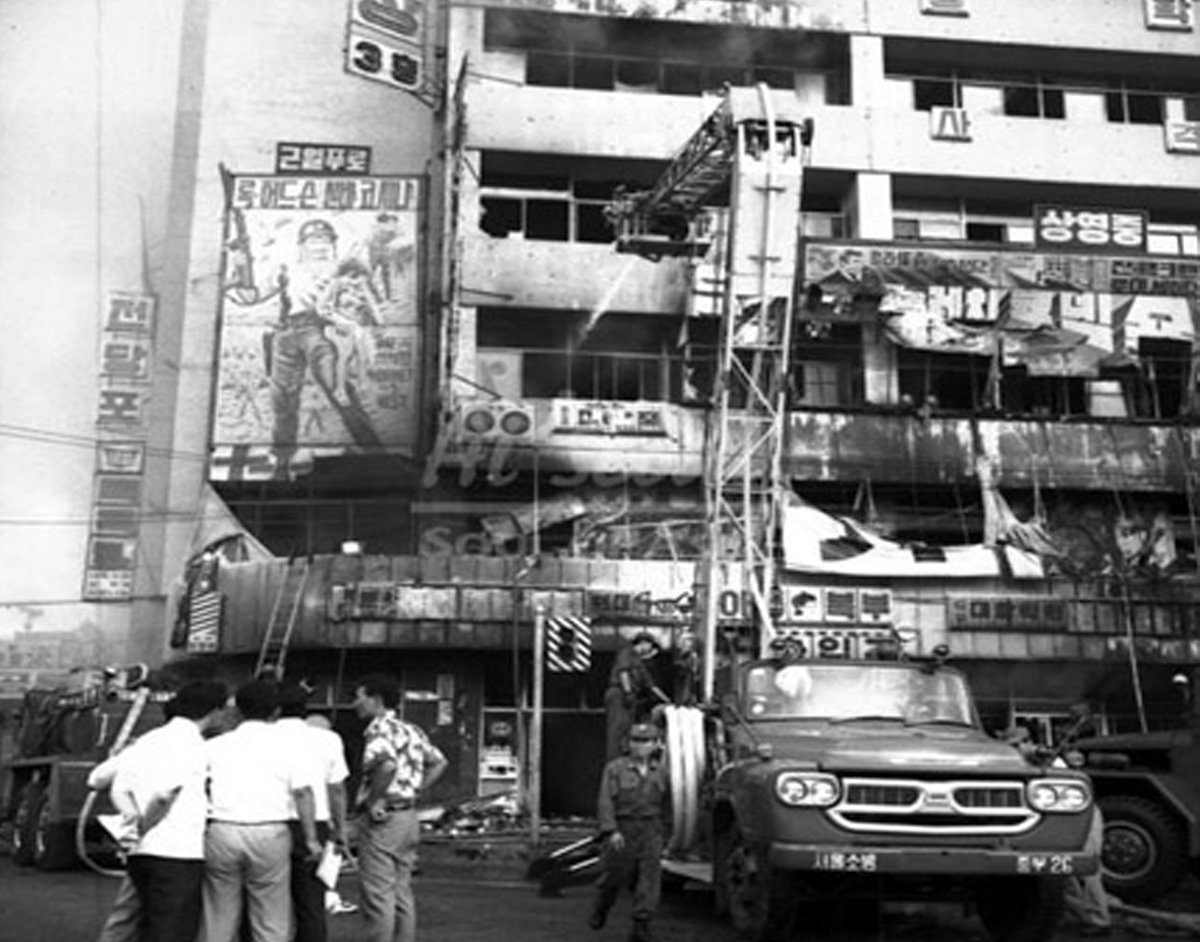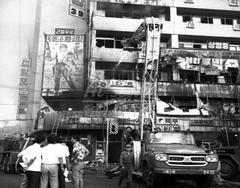
Seoul Gwangjin Fire Station Visiting Hours, Tickets, and Travel Guide
Date: 14/06/2025
Introduction
Seoul Gwangjin Fire Station is a cornerstone of public safety in Gwangjin-gu, one of Seoul’s dynamic eastern districts. Established in response to the district’s urban growth and its strategic proximity to the Han River and Achasan Mountain, the station is not only a vital emergency response hub but also an active center for community education and cultural engagement. Through its partnership with the Gwangnaru Safety Experience Center, it offers residents and visitors hands-on disaster preparedness programs and a unique window into Seoul’s advanced emergency management systems.
This comprehensive guide provides detailed information on the station’s history, organizational structure, community programs, visiting hours, ticketing, accessibility, and tips for making the most of your visit. Whether you are a local, a tourist interested in public safety or Seoul’s historical sites, or someone seeking interactive learning experiences, this article will help you plan an enriching visit.
For official updates and scheduling, consult the Gwangnaru Safety Experience Center and the Seoul Metropolitan Fire & Disaster Headquarters.
Table of Contents
- Historical Development and Significance
- Organizational Structure and Services
- Community Safety Programs & Visitor Experiences
- Technology, Training, and Resources
- Visiting Information: Hours, Tickets, and Accessibility
- Nearby Attractions
- Practical Tips for Visitors
- Frequently Asked Questions (FAQ)
- Conclusion
- References
Historical Development and Significance
Seoul Gwangjin Fire Station was founded as Gwangjin-gu emerged as a separate administrative district in 1995, reflecting the increasing need for dedicated emergency services amid rapid urbanization (Gwangjin District History). The area’s role as a transportation and commercial hub, with its proximity to the Han River and Achasan Mountain, further underscored the importance of robust disaster response capabilities (Gwangjin District Characteristics).
The station’s evolution was shaped by significant incidents, such as the 2010 Jamsil Bridge rescue tragedy, which led to enhanced training and safety protocols (Wikiwand - Seoul Gwangjin Fire Station). Today, the station integrates advanced technology and community outreach, making it a key institution for both emergency response and public education.
Organizational Structure and Services
Administrative Hierarchy
Seoul Gwangjin Fire Station operates under the Seoul Metropolitan Fire & Disaster Headquarters. The Fire Chief, holding the rank of Fire Superintendent, oversees a network of professional firefighters, paramedics, and support staff (Wikiwand - Seoul Gwangjin Fire Station).
Services and Subordinate Units
- 119 Safety Centers: Two sub-centers handle fire suppression, rescue, and emergency medical services.
- Field Response Unit: Specializes in hazardous materials, technical rescues, and large-scale incident coordination.
- Integration with Seoul IEMS: The station is fully integrated into Seoul’s 119 Integrated Emergency Management System for rapid, coordinated response (Seoul Solution PDF).
Interagency Collaboration
The station collaborates with city officials, police, hospitals, and disaster management offices, leveraging technology and joint training to ensure seamless emergency responses across Seoul (Seoul City Organizational History).
Community Safety Programs & Visitor Experiences
Gwangnaru Safety Experience Center
This modern, interactive facility offers immersive safety education for citizens and visitors (Gwangnaru Safety Experience Center). Programs include:
- Disaster Simulations: Earthquake, storm, and fire scenarios.
- CPR and First Aid Training: Hands-on instruction for all ages.
- Rescue Practice: Simulated emergency calls and rescue scenarios.
- Workshops and Professional Videos: For in-depth learning.
Public Engagement and Education
- Fire Prevention Campaigns: Outreach to schools, businesses, and residents.
- Community Workshops: Regular open house events, live drills, and equipment displays.
- Volunteer Programs: “Citizen firefighter” training for community members (Gwangjin-gu Tourist Office).
School & Youth Programs
The station collaborates with local schools for age-appropriate safety education, fostering civic responsibility and awareness among young people (Education for Foreign Residents).
Technology, Training, and Resources
Seoul Gwangjin Fire Station is equipped with state-of-the-art vehicles, GIS-based dispatch systems, and wireless communications for efficient response (Seoul Solution PDF, p. 15). Personnel undergo continuous training, including scenario-based drills at the Gwangnaru Safety Experience Center and advanced EMS certification (Seoul Metropolitan Fire Academy).
Visiting Information: Hours, Tickets, and Accessibility
Gwangnaru Safety Experience Center
- Hours: Open Monday–Friday, 9:00 AM–6:00 PM. Weekend hours and holiday closures may vary; always check the official website for updates.
- Tickets: Most programs are free or under 5,000 KRW; group bookings recommended during busy periods.
- Accessibility: Wheelchair-accessible entrances, multilingual guides (Korean, English, Chinese, Japanese), climate-controlled interiors, and lockers available.
- Location: Near Gunja Station and Children’s Grand Park Station on Seoul Metro.
Seoul Gwangjin Fire Station
- Public Tours: Available occasionally by prior arrangement, mainly for groups and during special events. Contact ahead to confirm availability.
- Admission: Free for tours and educational programs.
- Contact: Dial 119 for emergencies. For non-emergency inquiries, use the contact details on the Gwangjin-gu website.
Nearby Attractions
- Children’s Grand Park: Zoo, botanical gardens, amusement rides.
- Ttukseom Hangang Park: Riverside recreation.
- Achasan Mountain: Hiking trails with scenic views.
- Cultural Complex J-Bug: Exhibitions and performances.
- Cafes and Eateries: Numerous options nearby for refreshments.
Practical Tips for Visitors
- Advance Booking: Recommended for tours and group workshops.
- Dress Comfortably: Closed-toe shoes for active simulations.
- Bring ID: For reservations and group visits.
- Use Translation Apps: For non-Korean speakers.
- Follow Instructions: During drills and simulations.
- Supervise Children: Some experiences have age or height restrictions.
- Photography: Allowed in public areas; ask permission before photographing staff or sensitive equipment.
Frequently Asked Questions (FAQ)
Q: What are the Seoul Gwangjin Fire Station visiting hours?
A: The Gwangnaru Safety Experience Center is open Monday–Friday, 9:00 AM–6:00 PM. Public tours of the fire station are by appointment.
Q: How do I reserve tickets or book a tour?
A: Use the official website for reservations, or contact the station for group bookings.
Q: Are there English-language programs?
A: Yes, multilingual support and some programs are available in English.
Q: Is the facility accessible for people with disabilities?
A: Yes, the center offers wheelchair access and multilingual guides.
Q: Can I take photos during my visit?
A: Photography is allowed in most public areas, but please seek permission before photographing staff or equipment.
Conclusion
The Seoul Gwangjin Fire Station and Gwangnaru Safety Experience Center exemplify Seoul’s dedication to public safety, education, and cultural engagement. Whether you’re seeking interactive disaster preparedness training or a deeper understanding of Korea’s emergency services, your visit will be both educational and memorable. Make the most of your trip by planning ahead, taking advantage of accessible resources, and exploring the district’s vibrant attractions.
Stay connected with real-time updates and safety tips via the Audiala app, and follow official channels for the latest information on programs and events.
References
- Wikiwand - Seoul Gwangjin Fire Station
- Seoul Metropolitan Fire & Disaster Headquarters
- Gwangnaru Safety Experience Center
- Visit Seoul - Gwangnaru Safety Experience Center
- Gwangjin-gu Official Website
- Seoul Solution - 119 Integrated Emergency Management System
- Seoul Administrative History
- Seoul Metropolitan Fire Academy
- Trip.com Gwangnaru Disaster Experience Center
- Gwangjin-gu Facilities













































































































































































































